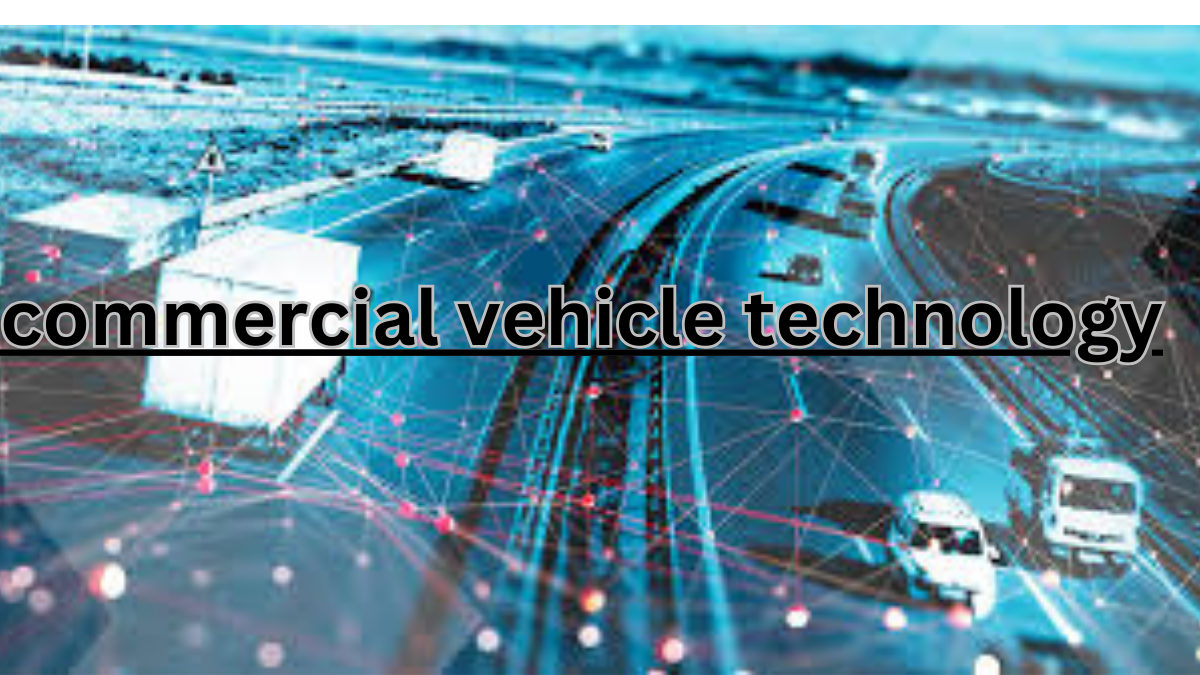Technology
What is the expected generation capacity of a 5 KW Solar System?

5KW Solar System:
An energy-conversion tool that converts solar energy into electrical power is the 5kw Solar System. It has sixteen 1.6 m × 1 m solar panels that can generate 320 W of power per unit, for a total of 5120 W, or 5 kWh. More power is produced when more solar panels are in operation. Each solar panel has wires connecting its solar cells, which produce electricity.
Technology
Revolutionizing Commercial Mobility: Exploring Cutting-Edge Vehicle Technology

In today’s rapidly evolving landscape, the realm of commercial mobility is undergoing a profound transformation, driven by cutting-edge vehicle technology. From electric vehicles (EVs) to autonomous vehicles (AVs), a plethora of innovations are revolutionizing how businesses move goods and people. In this article, we delve into the importance of embracing these advancements and explore their implications for the future of commercial mobility.
Introduction to Revolutionizing Commercial Mobility
Commercial mobility forms the backbone of global trade and commerce, facilitating the movement of goods and services across vast distances. However, traditional modes of transportation are facing increasing pressure to adapt to changing societal and environmental needs. This necessitates a paradigm shift towards more sustainable and efficient solutions, which is where cutting-edge vehicle technology comes into play.
Importance of Cutting-Edge Vehicle Technology
The integration of advanced technologies such as EVs, AVs, and connected vehicles holds immense potential to revolutionize commercial mobility in several key ways:
Electric Vehicles (EVs) in Commercial Mobility
Electric vehicles have emerged as a cornerstone of sustainable transportation, offering numerous advantages for commercial fleets:
Advantages of EVs:
- Environmental Sustainability: EVs produce zero tailpipe emissions, reducing the carbon footprint of commercial operations.
- Cost Savings: Lower fuel and maintenance costs make EVs a financially attractive option for businesses.
- Regulatory Compliance: With stringent emissions regulations, EVs help businesses meet environmental standards.
Challenges and Solutions:
- Range Anxiety: Limited range and charging infrastructure pose challenges for EV adoption. However, ongoing advancements in battery technology and infrastructure expansion are mitigating these concerns.
- Initial Cost: While EVs may have higher upfront costs, the total cost of ownership over the vehicle’s lifetime often proves to be lower compared to conventional vehicles.
Autonomous Vehicles (AVs) Transforming Commercial Mobility
Autonomous vehicles represent the pinnacle of technological innovation in commercial mobility, offering a myriad of benefits:
Benefits of AVs:
- Safety: AVs have the potential to drastically reduce accidents caused by human error, making roads safer for both drivers and pedestrians.
- Efficiency: AVs can optimize routes and reduce idle time, enhancing the efficiency of commercial operations.
- Productivity: With AVs, drivers can focus on higher-value tasks such as logistics management, improving overall productivity.
Safety Concerns and Regulatory Challenges:
- Technology Reliability: Ensuring the safety and reliability of AV technology remains a significant challenge, requiring rigorous testing and validation procedures.
- Regulatory Frameworks: The lack of uniform regulations governing AV deployment poses barriers to widespread adoption. Governments must establish clear guidelines to ensure the safe integration of AVs into commercial fleets.
Connected Vehicles enhance Commercial Mobility
The concept of connected vehicles revolves around enabling seamless communication between vehicles and infrastructure, paving the way for a more interconnected transportation ecosystem:
V2X Communication:
- Traffic Management: Connected vehicles can relay real-time traffic data to optimize route planning and reduce congestion.
- Safety Applications: V2X communication enables vehicles to exchange information about road conditions and potential hazards, enhancing overall safety.
Advanced Driver Assistance Systems (ADAS) in Commercial Vehicles
ADAS technologies encompass a range of features designed to assist drivers and enhance vehicle safety:
Features and Benefits:
- Adaptive Cruise Control: Automatically adjusts vehicle speed to maintain a safe following distance from other vehicles.
- Lane-Keeping Assistance: alerts drivers if they veer out of their lane and can even intervene to steer the vehicle back into the lane.
- Automatic Emergency Braking: Detects imminent collisions and applies the brakes to prevent or mitigate accidents.
Fuel Efficiency and Alternative Fuels in Commercial Vehicles
Achieving fuel efficiency is a paramount concern for commercial fleets, with ongoing efforts to explore alternative fuels and propulsion systems:
Advancements in Combustion Engines:
- Turbocharging and Direct Injection: These technologies improve the efficiency of internal combustion engines, reducing fuel consumption and emissions.
- Variable Valve Timing: Optimizes engine performance across different operating conditions, further enhancing fuel efficiency.
Exploration of Hydrogen and Other Alternative Fuels:
- Hydrogen Fuel Cells: Offer zero-emission propulsion for commercial vehicles, with the potential for rapid refueling and long-range capabilities.
- Biofuels: Derived from renewable sources such as plant matter or waste, biofuels offer a sustainable alternative to traditional fossil fuels.
Last-Mile Delivery Solutions for Commercial Mobility
Last-mile delivery presents unique challenges for commercial fleets, with innovative solutions emerging to address these hurdles:
Challenges in Last-Mile Delivery:
- Traffic Congestion: Urban areas often experience heavy traffic congestion, delaying delivery times and increasing costs.
- Parcel Theft: Porch piracy and package theft pose significant challenges for last-mile delivery providers, requiring robust security measures.
Technologies Addressing Last-Mile Delivery Issues:
- Electric Delivery Vans: Offer emissions-free delivery solutions for urban areas, reducing pollution and noise levels.
- Drones and Autonomous Robots: Can navigate congested urban environments to deliver packages quickly and efficiently, bypassing traditional traffic constraints.
Predictive Maintenance in Commercial Fleets
Predictive maintenance leverages data analytics and IoT sensors to anticipate and prevent mechanical failures before they occur:
Importance of Predictive Maintenance:
- Cost Savings: By identifying potential issues early, predictive maintenance reduces downtime and costly repairs.
- Enhanced Reliability: Commercial fleets can operate with greater confidence, knowing that their vehicles are well-maintained and reliable.
Implementation and Benefits:
- IoT Sensors: Monitor key vehicle components in real-time, detecting anomalies and predicting maintenance needs.
- Data Analytics: Analyze vehicle performance data to identify patterns and trends, enabling proactive maintenance interventions.
Vehicle-to-Grid (V2G) Integration in Commercial Mobility
V2G technology enables bidirectional energy flow between electric vehicles and the power grid, unlocking new opportunities for energy management:
Utilizing EV Batteries for Grid Stability:
- Peak Load Management: EV batteries can store excess energy during off-peak hours and discharge it during peak demand periods, helping to stabilize the grid.
- Renewable Energy Integration: V2G facilitates the integration of renewable energy sources by providing energy storage capabilities and grid-balancing services.
Opportunities and Challenges:
- Revenue Generation: Commercial fleet operators can earn revenue by participating in demand response programs and providing grid services.
- Battery Degradation: Extensive cycling of EV batteries for grid services may accelerate degradation, requiring careful management to optimize battery lifespan.
Subscription-Based Mobility Services for Businesses
Subscription-based mobility services offer businesses flexibility and cost savings when accessing commercial vehicles:
Flexibility and Cost Savings:
- Pay-Per-Use Model: Businesses can access vehicles on-demand without the burden of ownership, paying only for the services they need.
- Maintenance and Insurance Included: Subscription packages often include maintenance and insurance, further reducing operational overhead for businesses.
Future Trends in Mobility Services:
- Integration with Autonomous Vehicles: Subscription-based mobility services are poised to integrate with AVs, offering businesses access to self-driving fleets on a subscription basis.
- Customization and Personalization: As technology advances, mobility service providers will offer increasingly tailored solutions to meet the unique needs of businesses.
Role of Regulatory and Policy Frameworks in Commercial Mobility
Government initiatives and regulations play a pivotal role in shaping the future of commercial mobility:
Government Initiatives Supporting Sustainable Transportation:
- Incentives for EV Adoption: Governments worldwide offer incentives such as tax credits and rebates to encourage businesses to adopt EVs.
- Investment in Infrastructure: Funding for charging infrastructure and research into alternative fuels accelerates the transition to sustainable transportation.
Impact on Industry Innovation:
- Standardization and Interoperability: Clear regulatory frameworks promote innovation by providing certainty and encouraging investment in new technologies.
- Collaboration and Partnership: Governments, industry stakeholders, and academia collaborate to develop cohesive strategies for advancing commercial mobility.
Conclusion: Embracing Innovation for a Sustainable Future in Commercial Mobility
In conclusion, the revolutionizing of commercial mobility through cutting-edge vehicle technology heralds a new era of efficiency, safety, and sustainability. From electric and autonomous vehicles to connected systems and predictive maintenance, businesses have a myriad of tools at their disposal to navigate the evolving transportation landscape. By embracing innovation and collaboration, we can create a future where commercial mobility is not only efficient and profitable but also environmentally sustainable.
FAQs
1. How do electric vehicles contribute to commercial mobility? Electric vehicles offer numerous benefits for commercial fleets, including reduced emissions, lower operating costs, and regulatory compliance.
2. What are the safety concerns associated with autonomous vehicles?
Safety concerns with autonomous vehicles include technology reliability, cybersecurity risks, and regulatory uncertainties regarding liability and insurance.
3. How does predictive maintenance benefit commercial fleets? Predictive maintenance helps commercial fleets reduce downtime, lower maintenance costs, and enhance vehicle reliability by anticipating and preventing mechanical failures.
4. What role do regulatory frameworks play in shaping commercial mobility?
Regulatory frameworks govern vehicle safety standards, emissions regulations, and infrastructure development, influencing the adoption of new technologies and business models in commercial mobility.
5. Are subscription-based mobility services cost-effective for businesses?
Subscription-based mobility services offer businesses flexibility and cost savings by providing access to vehicles on-demand without the burden of ownership, often including maintenance and insurance in the package.
Technology
Understanding Digital Fingerprints: Getting Around the Internet Identity

Introduction
In today’s digital age, the concept of a “digital fingerprints” has become increasingly important. From cybersecurity to copyright protection, digital fingerprinting plays a crucial role in various aspects of our online lives.
Understanding Digital Fingerprinting
Definition and Purpose
A hash value, digital fingerprint, or digital signature is a unique identifier made from digital data. Its purpose is to uniquely identify a specific content or digital file.
Digital fingerprints are unique identifiers that are created when a user interacts with digital devices or platforms. Numerous characteristics, including device information, surfing history, and user behaviour, are taken into account when creating these fingerprints. Companies may target ads, analyze user behavior, and personalize content by using them to track and identify specific individuals online.
The Creation of Digital Fingerprints
Algorithms that provide a distinct hash value depending on the contents of the file are used to establish digital fingerprints. The integrity and validity of the file are then confirmed using this hash value.
Applications of Digital Fingerprinting
Cybersecurity
Cybersecurity professionals frequently employ digital fingerprinting to identify and stop unwanted access to sensitive data and digital networks. By creating a unique fingerprint for each user or device, organizations can track and monitor activities to identify potential security threats.
Copyright Protection
In the realm of content creation and distribution, digital fingerprinting is used to protect intellectual property rights. By embedding unique identifiers into digital files, content creators can track the usage of their work and take legal action against unauthorized distribution or reproduction.
Fraud Prevention
Financial institutions and e-commerce platforms use digital fingerprinting to detect and prevent fraudulent activities such as identity theft and payment fraud. By analyzing user behavior and transaction patterns, organizations can identify suspicious activities and take appropriate measures to mitigate risk.
Techniques Used in Digital Fingerprinting
Hash Functions
Hash functions play a central role in digital fingerprinting by generating unique hash values from input data. Common hash functions include MD5, SHA-1, and SHA-256, each offering varying levels of security and collision resistance.
Watermarking
Via a technique known as watermarking, digital fingerprints can be directly included into multimedia files, such as images, videos, and audio files. The content’s integrity may be verified by removing these watermarks, even if they are undetectable to the unaided eye.
Machine Learning
Advancements in machine learning algorithms have enabled more sophisticated approaches to digital fingerprinting. Machine learning techniques can analyze large datasets to identify patterns and anomalies, improving the accuracy and efficiency of digital fingerprinting systems.
Challenges and Limitations
Privacy Concerns
One of the primary concerns surrounding digital fingerprinting is the potential invasion of privacy. Data breaches and other security breaches are becoming more likely due to the increasing use of digital fingerprints.
False Positives
Digital fingerprinting systems are not infallible and may sometimes produce false positives, incorrectly identifying legitimate content as suspicious or infringing. This can lead to unnecessary disruptions and legal challenges for content creators and users.
Importance of Digital Fingerprinting in Today’s World
The significance of digital fingerprinting cannot be emphasized in a time when information and digital assets are always under danger. From protecting intellectual property to safeguarding personal data, digital fingerprinting technologies play a vital role in maintaining trust and security in the digital ecosystem.
Future Trends and Innovations
As technology continues to evolve, we can expect to see further advancements in digital fingerprinting techniques and applications. From blockchain-based solutions to AI-driven authentication systems, the future of digital fingerprinting holds promise for enhanced security and efficiency.
Conclusion
In conclusion, digital fingerprinting is a fundamental technology that underpins many aspects of our digital lives. Whether it’s ensuring the security of our online transactions, protecting the integrity of digital content, or combating cyber threats, digital fingerprinting plays a crucial role in maintaining trust and confidence in the digital world.
FAQs
1. How does digital fingerprinting differ from traditional fingerprinting?
While traditional fingerprinting involves physical impressions of unique patterns on an individual’s fingers, digital fingerprinting generates unique identifiers from digital data such as files or documents.
2. Is digital fingerprinting only used for security purposes?
No, digital fingerprinting has diverse applications beyond cybersecurity, including copyright protection, fraud prevention, and content identification.
3. Does digital fingerprinting carry any legal ramifications?
Yes, the use of digital fingerprinting for copyright enforcement and surveillance purposes has raised legal and ethical concerns regarding privacy rights and freedom of expression.
4. Is it possible to change or fake digital fingerprints?
Although it is theoretically conceivable to modify or fake digital fingerprints, most opponents would likely see this as impracticable given the advanced procedures required.
5. How can individuals protect their privacy in an age of digital fingerprinting?
Individuals can protect their privacy by being cautious about the information they share online, using encryption and secure communication channels, and staying informed about digital security best practices.
Technology
American battery technology companies’ most recent innovations and developments

The field of battery technology is undergoing a dramatic transition, driven by the unwavering quest for sustainability and innovation. Across the United States, several companies are at the forefront of this transformation, pioneering breakthroughs that promise to revolutionize various industries. Let’s delve into the latest news and advancements from these American battery technology companies.
Tesla’s Latest Innovations in Battery Technology
Under Elon Musk’s visionary leadership, Tesla continues to spearhead advancements in battery technology. The company’s Gigafactories churn out batteries for their electric vehicles and energy storage solutions. Tesla’s relentless focus on improving battery efficiency, longevity, and sustainability has propelled the electric vehicle market forward and garnered significant attention from investors and consumers alike.
QuantumScape: Pioneering Solid-State Batteries
QuantumScape is making waves in the battery industry with its groundbreaking solid-state battery technology. By replacing traditional liquid electrolytes with solid-state materials, QuantumScape aims to overcome many limitations of conventional lithium-ion batteries, such as energy density, charging speed, and safety concerns. With substantial investments and promising results in their development efforts, QuantumScape is poised to redefine the future of electric vehicles and energy storage systems.
Solid Power’s Advancements in Battery Development
Solid Power is another key player in the pursuit of next-generation battery solutions. Specializing in solid-state battery technology, Solid Power aims to commercialize batteries with higher energy density, faster charging capabilities, and enhanced safety features. With partnerships with major automotive manufacturers like BMW and Ford, Solid Power’s innovations hold immense potential for accelerating the adoption of electric vehicles and renewable energy storage systems.
Enevate Corporation: Silicon-Dominant Li-ion Batteries
Enevate Corporation is leveraging silicon-dominant lithium-ion battery technology to address the pressing need for faster-charging batteries with increased energy density. By incorporating silicon into the battery anode, Enevate’s technology enables rapid charging without compromising battery life or performance. This innovation could significantly enhance the practicality and convenience of electric vehicles, making them more appealing to consumers worldwide.
Ambri’s Liquid Metal Battery Technology
Ambri is pioneering the development of liquid metal battery technology for grid-scale energy storage applications. By utilizing low-cost materials and innovative design principles, Ambri’s batteries have the potential to store large amounts of renewable energy generated from sources like wind and solar. This breakthrough could play a crucial role in balancing the grid, improving energy reliability, and accelerating the transition to a sustainable energy future.
Recent Developments and Breakthroughs in Battery Technology
In addition to these key players, numerous other American battery technology companies are making significant strides in the field. The battery sector is expanding quickly, thanks to developments in materials science and innovative production methods. Recent developments include improved cathode and anode materials, solid-state electrolytes, and advancements in battery management systems.
Impact of Battery Innovations on Electric Vehicles
The advancements in battery technology have profound implications for the electric vehicle market. Higher energy density batteries enable longer driving ranges, faster charging times, and enhanced performance, addressing key barriers to mainstream adoption. As battery costs continue to decline and energy densities increase, electric vehicles are becoming increasingly competitive with internal combustion engine vehicles, driving the shift towards electrification.
Role of Batteries in Renewable Energy Storage
Batteries also play a crucial role in storing renewable energy generated from sources like solar and wind. As the share of renewables in the energy mix grows, effective energy storage solutions become essential for balancing supply and demand, mitigating intermittency, and ensuring grid stability. Battery storage systems enable the seamless integration of renewable energy into the grid, reducing reliance on fossil fuels and accelerating the transition to a clean energy future.
Challenges and Opportunities in the Battery Industry
Despite the promising advancements, the battery industry faces various challenges, including raw material shortages, manufacturing constraints, and technological barriers. However, these challenges also present opportunities for innovation and collaboration. Companies that can overcome these hurdles stand to reap substantial rewards in the rapidly expanding market for batteries.
Investment Trends in American Battery Technology Companies
The growing interest in clean energy and electric transportation has spurred significant investments in American battery technology companies. Venture capital firms, corporate investors, and government entities are pouring funds into research and development efforts aimed at accelerating the deployment of advanced battery technologies. This influx of capital underscores the immense potential of the battery industry to drive sustainable economic growth and environmental stewardship.
Regulatory Landscape and Policies Affecting Battery Technology
The regulatory landscape also plays a crucial role in shaping the trajectory of the battery industry. Government policies, incentives, and regulations influence investment decisions, market dynamics, and technological innovation. Supportive policies promote research and development, incentivize clean energy adoption, and facilitate market deployment.
Future Outlook for American Battery Technology Companies
Looking ahead, the future appears bright for American battery technology companies. With ongoing advancements in materials science, manufacturing processes, and energy storage technologies, the potential for further innovation and disruption is immense. As the world transitions towards a low-carbon economy, batteries will play an increasingly integral role in powering sustainable transportation, renewable energy systems, and grid infrastructure.
Conclusion
In conclusion, American battery technology companies are at the forefront of innovation, driving the transformation towards a cleaner, more sustainable future. From Tesla’s cutting-edge electric vehicles to QuantumScape’s solid-state batteries and Ambri’s grid-scale energy storage solutions, these companies are revolutionizing industries and shaping the way we power our world. As investments pour in, regulations evolve, and technologies mature, the outlook for the battery industry remains exceptionally promising.
FAQs about American Battery Technology Companies:
1. What sets solid-state batteries apart from traditional lithium-ion batteries?
Solid-state batteries offer advantages such as higher energy density, faster charging, and enhanced safety compared to traditional lithium-ion batteries.
2. How do battery innovations impact the cost of electric vehicles?
Advances in battery technology are driving down the cost of electric vehicles by reducing the cost per kilowatt-hour of battery storage, making electric vehicles more affordable and accessible to consumers.
3. What role do government incentives play in the growth of the battery industry?
Government incentives, such as tax credits and grants, encourage investment in battery technology research, development, and manufacturing.
4. Are there any environmental considerations associated with battery production and disposal?
Battery production and disposal raise environmental concerns related to resource extraction, energy consumption, and waste management. However, advancements in recycling and sustainable practices are addressing these challenges.
5. How do battery technologies contribute to the transition to renewable energy?
Battery storage systems enable the efficient integration of renewable energy into the grid by storing excess energy generated from sources like solar and wind.
-

 Health8 months ago
Health8 months agoHealth Content on theapknews.shop: Keeping Readers Informed and Healthy
-

 How To7 months ago
How To7 months agoExploring How Geospatial Technologies Illuminate Our World
-

 Pets8 months ago
Pets8 months agoUncovering the Jovial Internet Expression “What the Heckin’ Dog”
-

 Health8 months ago
Health8 months agofuture health software could change healthcare(An Overview)
-

 Technology8 months ago
Technology8 months agoCraft Design Technology
-

 Technology7 months ago
Technology7 months agoAmerican Made Streaming: Exploring Entertainment Options
-

 News8 months ago
News8 months agoShedding light on the History of Ertugrul Ghazi
-

 Technology7 months ago
Technology7 months agoRevealing the Geekzilla.tech Marvels: Honour Magic5 Pro


